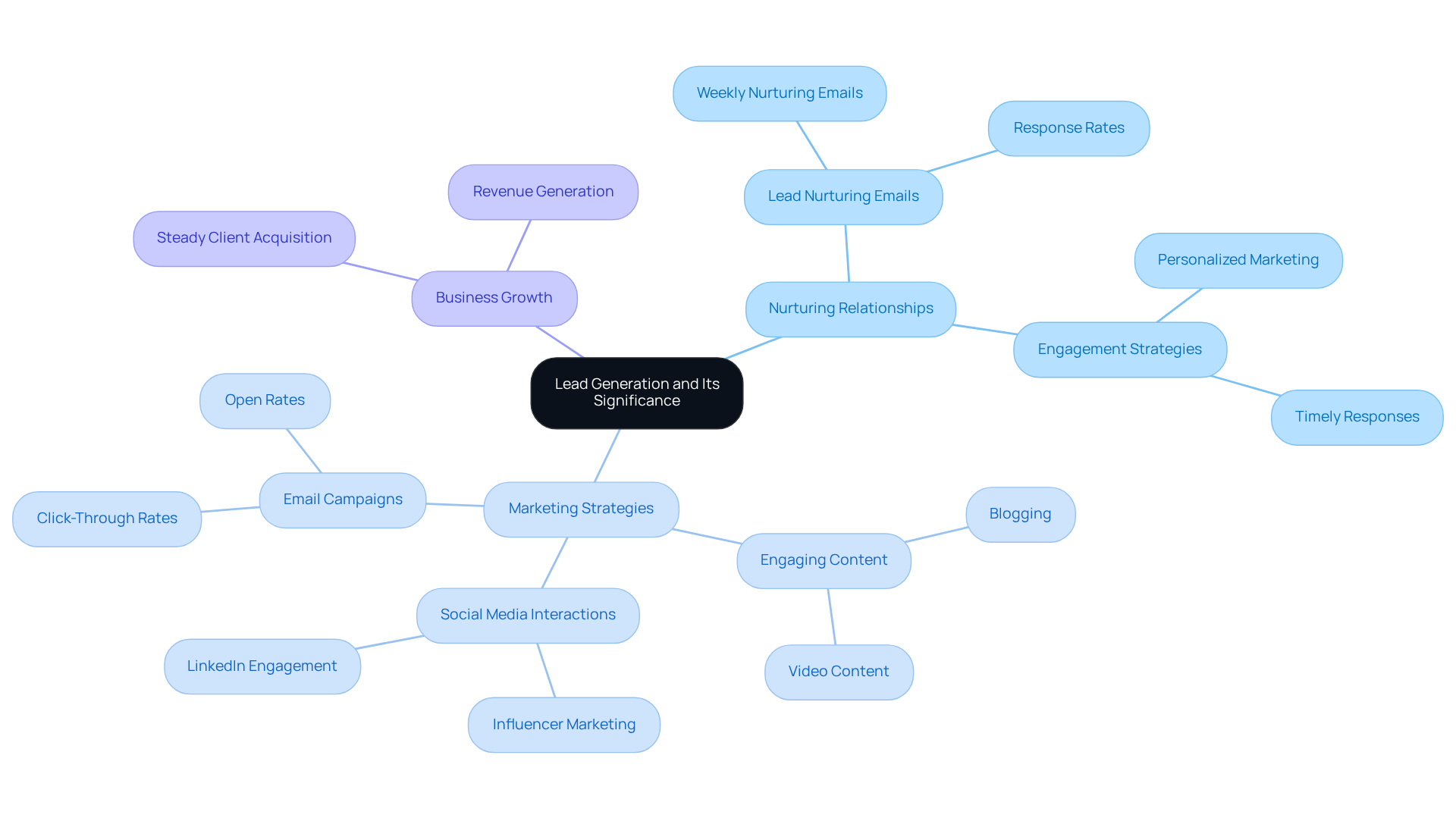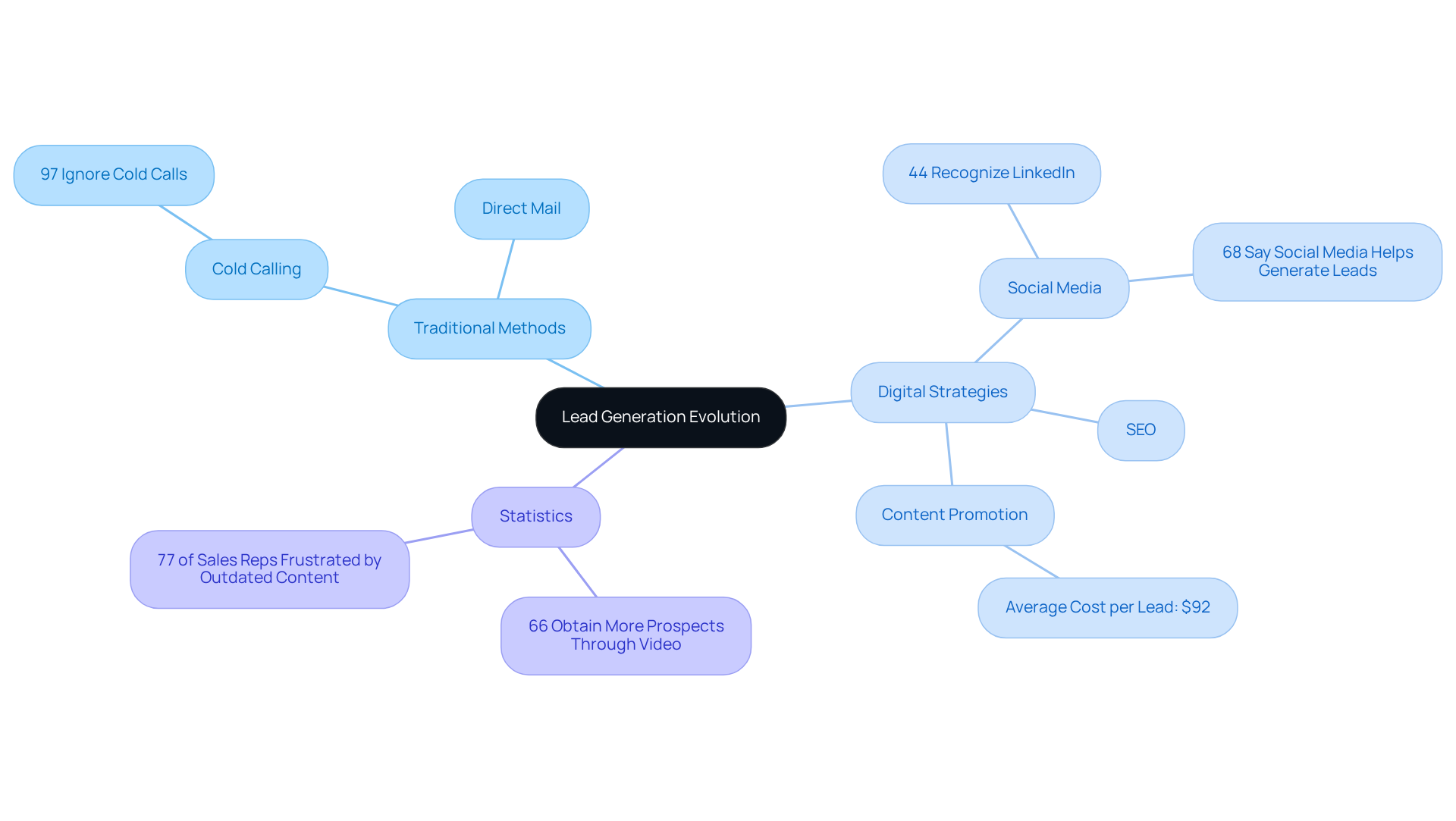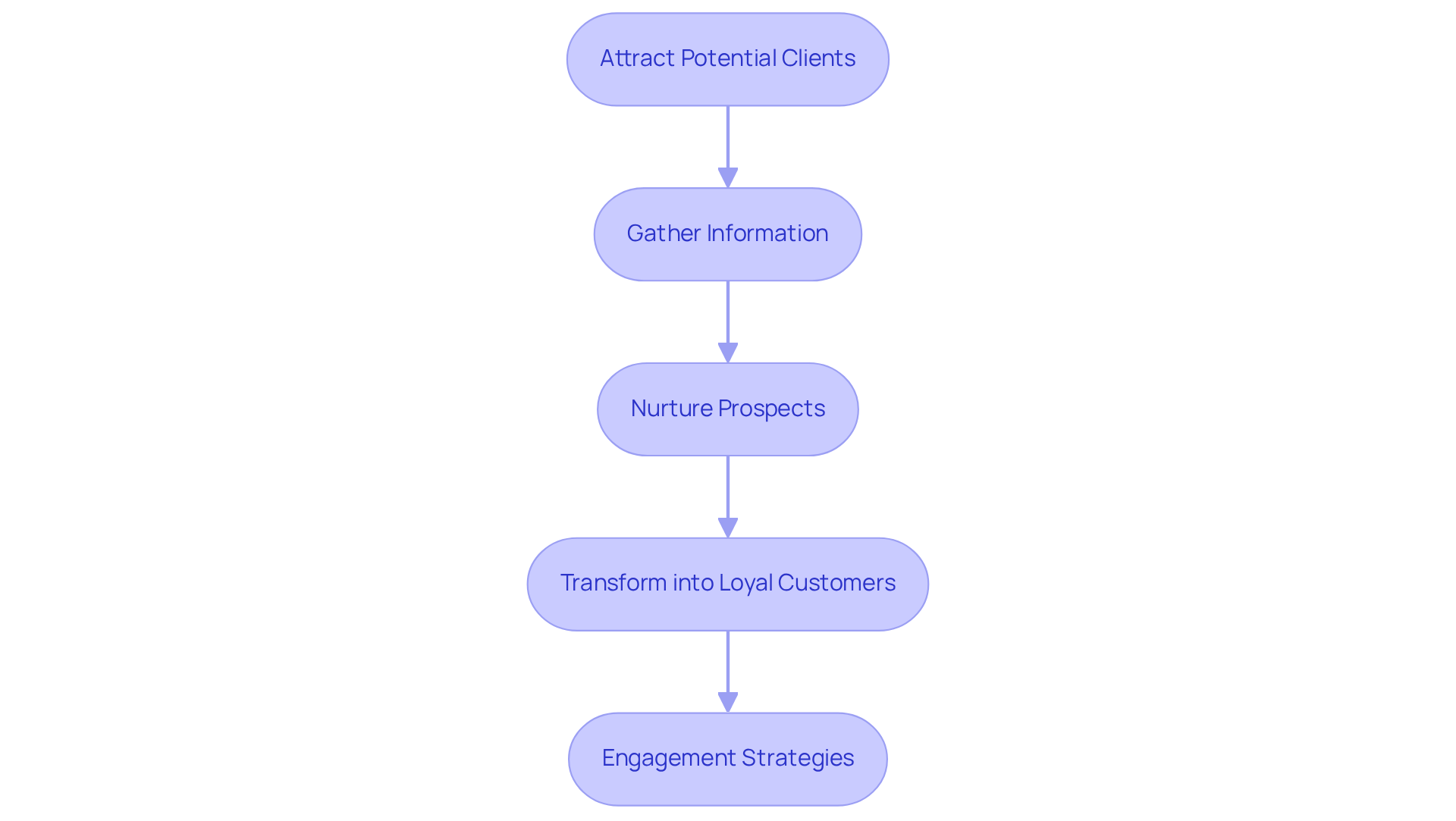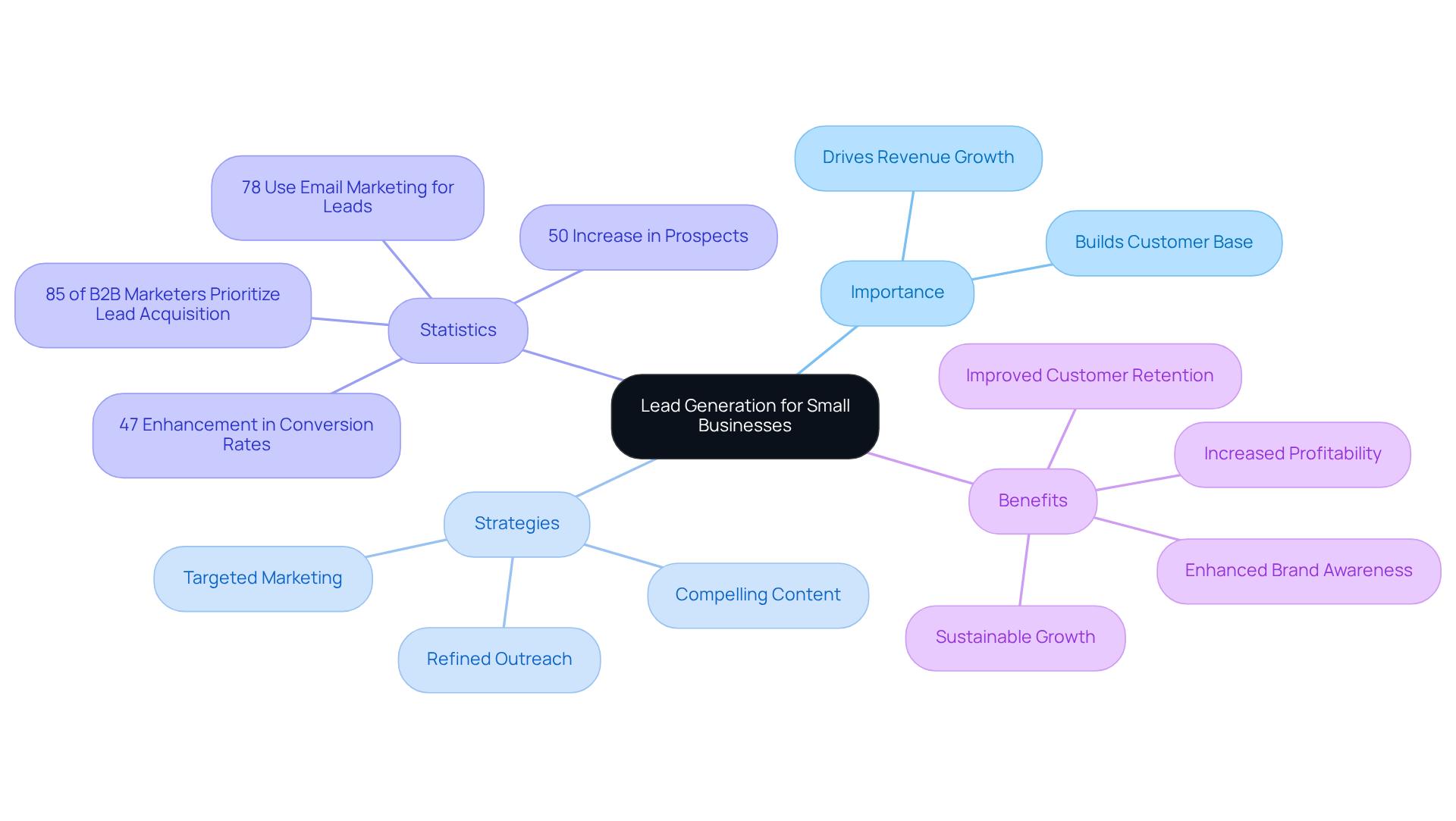Overview
Lead generation is not just a process; it’s a vital step in nurturing potential customers who have expressed interest in your products or services. For small businesses aiming for sustainable growth, this process is crucial. By implementing effective lead generation strategies, such as leveraging digital marketing and automation tools, you can significantly enhance customer acquisition. Moreover, these strategies improve your brand visibility and profitability, which are essential for thriving in today’s competitive market.
We understand your challenges as small business owners. It can feel overwhelming to stand out and attract the right customers. However, by focusing on lead generation, you can build a strong foundation for your business. Imagine how much easier it would be to connect with customers who truly value what you offer. Together, we can explore these strategies that not only address your concerns but also empower you to take action and achieve success.
Introduction
Lead generation is a vital foundation for small businesses striving to thrive in today’s competitive landscape. This dynamic process not only attracts potential customers but also nurtures relationships that can lead to sustained growth and profitability.
As marketing strategies rapidly evolve—from traditional outreach to sophisticated digital techniques—many small business owners find themselves grappling with how to implement these changes effectively.
How can they harness the power of lead generation to not just survive, but truly flourish in an increasingly digital marketplace? Together, we can explore these challenges and find meaningful solutions.
Define Lead Generation and Its Significance
Lead acquisition is more than just a process; it's about nurturing relationships with prospective customers who have expressed interest in your products or services. This interest can blossom through various marketing strategies, such as engaging content, lively social media interactions, and thoughtful email campaigns. Understanding the importance of prospect acquisition is crucial, as it establishes a steady stream of potential clients, which is vital for your business's growth and sustainability.
Without , many small business owners face the daunting challenge of finding new clients, which can directly impact income and market presence. We understand your challenges and are here to support you in overcoming them. By focusing on generation lead acquisition, you can create a foundation that attracts new clients and fosters lasting relationships that contribute to your success.

Explore the Evolution and Context of Lead Generation
Lead generation has undergone a remarkable transformation, evolving from traditional methods like cold calling and direct mail to sophisticated digital strategies that leverage data and technology, enhancing the overall process. We understand how challenging it can be to navigate these changes, especially when historical approaches often relied on manual outreach and personal connections. This frequently led to limited reach and effectiveness. For example, a staggering 97% of people ignore cold calls, which highlights the ineffectiveness of this traditional approach. Thankfully, the rise of the internet and digital promotion has revolutionized this process, enabling businesses to adopt more targeted and efficient methods.
Today, companies can harness the power of , search engine optimization (SEO), and content promotion for effective lead generation. It’s encouraging to note that 44% of B2B marketers recognize LinkedIn as the most effective platform for generating prospects. This underscores the importance of social media in contemporary outreach efforts. Moreover, content promotion has proven to be a budget-friendly approach, producing prospects at an average expense of just $92—significantly less than conventional techniques that often deliver fewer outcomes.
This evolution illustrates a broader trend towards lead generation in data-driven decision-making in the field of promotion. Companies now employ advanced analytics to enhance their lead generation strategies, ensuring they connect with the right audience at the right moment. Additionally, 66% of promoters indicate that they are obtaining more qualified prospects through video promotion. This highlights the necessity for varied digital approaches. Consequently, lead generation through prospect development has become an essential element of modern promotional strategies, allowing small enterprises to compete successfully in an increasingly digital marketplace.
Together, we can navigate these changes and embrace new opportunities for growth. By adapting to these innovative strategies, you can enhance your outreach efforts and connect with your audience more effectively.

Identify Key Components and Processes of Lead Generation
Successful client acquisition is crucial for your business, and it hinges on a few essential factors: identifying your target audience, creating engaging content, and utilizing various channels to connect with prospective customers. The [prospect generation process](https://blog.wayy.ai/10-lead-generation-methods-for-small-business-success) unfolds in distinct phases.
- Draw in potential clients through strategic promotional efforts.
- Gather their information via forms or landing pages.
- Nurture these prospects through personalized communication, ultimately transforming them into loyal customers.
Have you considered how a combination of inbound and outbound promotional techniques can significantly enhance your engagement with prospects at different phases of the buying journey? For instance, businesses that release at least 16 articles each month generate 4.5 times more prospects than those that publish less. Additionally, 72% of advertisers confirm that content strategies boost prospects, highlighting their effectiveness in the early stages of the sales funnel.
To streamline these processes, tools like CRM systems and promotional automation platforms are invaluable. In fact, marketing automation can lead to a remarkable 451% growth in qualified leads, showcasing its importance in nurturing and converting prospects. Moreover, 64% of B2B firms report that marketing automation enhances process efficiency, allowing small businesses to focus on building relationships with prospects rather than being overwhelmed by manual tasks.
Consider the insights from case studies: a survey of over 2,000 social media marketers revealed that 25% prioritize acquiring prospects as their primary learning objective, emphasizing the growing recognition of its importance. Furthermore, firms that effectively refine their follow-up approaches can significantly boost prospect velocity rates, ensuring timely interactions with potential clients. By combining these elements and processes, small enterprises can create a robust lead development structure that fosters growth and enhances customer acquisition. Together, we can and achieve success.

Understand the Importance of Lead Generation for Small Businesses
Lead acquisition is a vital aspect for small enterprises striving to build a robust customer base and drive revenue growth. We understand that, unlike larger corporations, small businesses often operate with limited resources. This necessitates a strategic approach to optimize marketing efforts effectively. By employing efficient customer acquisition tactics, small enterprises can focus on generation lead to identify and engage with potential clients, transforming them into loyal patrons. This journey not only but also strengthens credibility within their markets.
Consider this: companies that consistently generate high-quality prospects through their generation lead efforts can enjoy sustainable growth, improved customer retention, and increased profitability. Statistics reveal that businesses utilizing AI in their prospect acquisition efforts report up to a 50% increase in prospects and a 47% enhancement in conversion rates. This highlights the importance of embracing technology in these strategies. Additionally, a significant 85% of B2B marketers prioritize prospect acquisition, underscoring its role in enhancing sales and market visibility.
By concentrating on targeted marketing, crafting compelling content, and refining outreach efforts, small businesses can markedly improve their generation lead success rates. Together, these strategies can pave the way for greater revenue growth. Remember, you are not alone in this journey; we can achieve success together by focusing on what truly matters for your business.

Conclusion
Lead generation is essential for small businesses striving to succeed in competitive markets. By nurturing relationships with potential customers and embracing innovative marketing strategies, businesses can create a steady stream of prospects vital for sustainable growth and success.
This article explores the evolution of lead generation, emphasizing the transition from traditional methods to modern digital strategies. Key insights reveal the importance of:
- Reaching the right audience
- Leveraging content marketing
- Utilizing automation tools to simplify the acquisition process
Statistics illustrate how effective lead generation not only enhances customer engagement but also increases conversion rates, highlighting its crucial role in driving revenue for small enterprises.
Embracing these lead generation strategies is not just an option; it’s a necessity for small businesses looking to enhance their market presence and profitability. By concentrating on building meaningful connections with prospects, companies can navigate challenges and seize opportunities for growth. It’s time for small business owners to prioritize lead generation, harness its potential, and transform their customer acquisition efforts into a powerful engine for success. Together, we can achieve remarkable outcomes.
Frequently Asked Questions
What is lead generation?
Lead generation is the process of acquiring and nurturing relationships with prospective customers who have shown interest in your products or services.
Why is lead generation significant for businesses?
Lead generation is significant because it establishes a steady stream of potential clients, which is essential for the growth and sustainability of a business.
What strategies can be used for lead generation?
Lead generation strategies can include engaging content, lively social media interactions, and thoughtful email campaigns.
What challenges do small business owners face regarding customer acquisition?
Small business owners often struggle to find new clients without effective customer acquisition strategies, which can negatively affect their income and market presence.
How can focusing on lead generation help small businesses?
By focusing on lead generation, small businesses can create a foundation that attracts new clients and fosters lasting relationships, contributing to their overall success.




